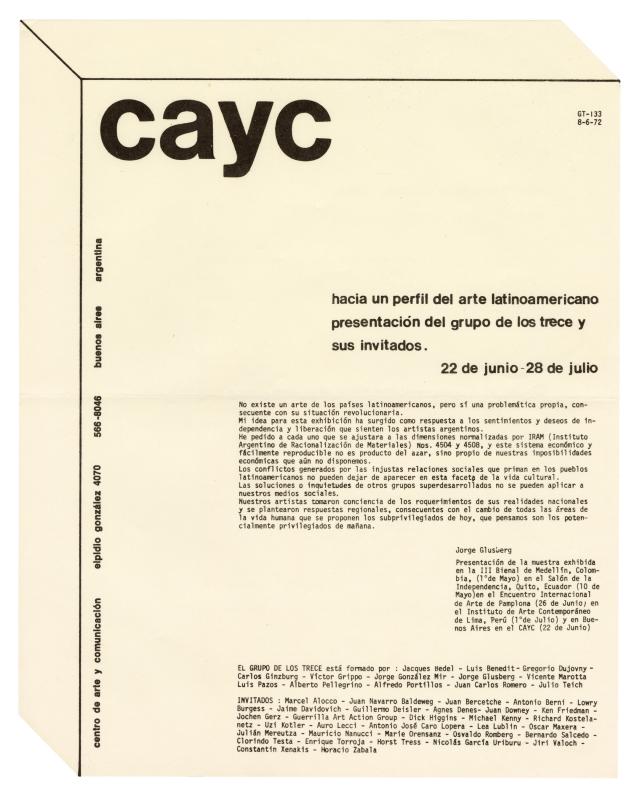Ever since it was founded, the CAYC (Centro de Arte y Comunicación), helmed by the cultural promoter, artist, and businessman Jorge Glusberg, was intended as an interdisciplinary space where an experimental art movement could flourish. The establishment of collaborative networks connecting local and international artists and critics played a key role in this process. The exhibitions shone a light on these exchanges, in which overviews of trends or individual artists introduced the innovations of international contemporary art and made Argentine and Latin American artists better known on the global scene.
The CAYC’s proposal ushered in a new stage, becoming more involved with the North American circuit. This newsletter announces the opening of Hacia un perfil del arte latinoamericano, in March 1974, in an academic college setting at the Dudley Peter Allen Memorial Art Museum, at Oberlin College, Ohio, after its long international tour, which took it to the III Bienal de Arte Coltejer (Medellín, Colombia, May 1972), the Salón de la Independencia (Quito, Ecuador, May 1972), Buenos Aires (June 1972), the Encuentro Internacional de Arte de Pamplona (June 1972), and the Amadis gallery in Madrid (February 1973).
Hacia un perfil… showed works in which Argentinean and international artists pondered the political situation that was common to all their countries. The exhibition provided a perspective on art and the Grupo de los Trece’s ideology in a concise overview of contemporary regional art. The CAYC’s version of arte de sistemas (systems art) not only referred to international process art; its political stance, absorbed over the course of its many productions and presentations, gave it an identity of its own and associated it with a regional identity. In his introduction to the exhibition, Glusberg said: “There is no Latin American art as such, but the region’s individual countries do share a common problem in terms of their revolutionary situation.” [GT-133 (doc. no. 1476312)]
The Grupo de los Trece, a group of CAYC artists, had introduced itself officially in Colombia. The original members were Jacques Bedel, Luis (Fernando) Benedit, Gregorio Dujovny, Carlos Ginzburg, Víctor Grippo, Jorge González Mir, Jorge Glusberg, Vicente Marotta, Luis Pazos, Alberto Pellegrino, Alfredo Portillos, Juan Carlos Romero, and Julio Teich. Horacio Zabala and the architect Clorindo Testa, who are listed here as guest artists, joined the group at a later date.
This exhibition, originally designed in 1972, became the template for future CAYC exhibitions, which all relied on heliographic prints; in Glusberg’s words, this “was not a random choice, but a direct consequence of our inability to compete with technological mediums and operating budgets that we do not yet have.” This new medium’s enormous serializing potential and low cost made it possible to circulate images more widely and exhibit them in several places at the same time, with selective variations in the list of guest artists from Argentina and elsewhere.

